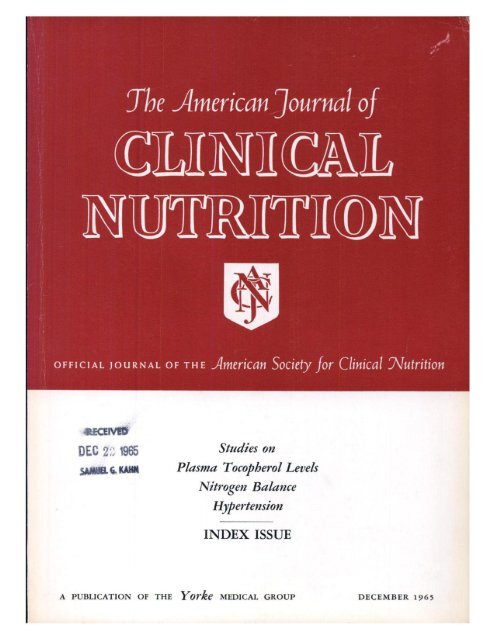英国生物银行坚持吃柳叶刀饮食、生物衰老和预期寿命:一项队列研究。
IF 6.5
1区 医学
Q1 NUTRITION & DIETETICS
引用次数: 0
摘要
背景:EAT-Lancet饮食法是为了促进人类健康和支持环境可持续性而提出的。然而,EAT-Lancet饮食、生物衰老和预期寿命之间的相互作用尚未得到探讨。目的:我们旨在研究EAT-Lancet饮食模式与生物衰老和预期寿命的关系,以及遗传易感性的潜在改变效应。方法:对英国生物银行队列研究数据进行分析。使用24小时饮食回忆数据计算EAT-Lancet饮食指数,以评估EAT-Lancet饮食的依从性。构建多基因风险评分(PRSs)来评估生物衰老的遗传风险。采用多变量线性回归和柔性参数生存模型分别研究EAT-lancet饮食指数与生物衰老加速和剩余寿命的关系。使用中介分析来识别潜在的中介。结果:在141562名纳入的参与者中(56.02±7.94岁,45.12%为男性),那些坚持EAT-Lancet饮食的人与较慢的生物衰老速度显著相关(对于Stubbendorff EAT-Lancet饮食指数:KDM-BA加速:-1.37年,95% CI: -1.51, -1.24;表型加速:-0.93年,95% CI: -1.00, -0.86;结论:无论遗传易感性如何,坚持EAT-lancet饮食与延缓生物衰老和延长预期寿命有关。这表明,促进这种可持续的饮食模式可以作为一种实用的营养策略,以提高健康寿命。本文章由计算机程序翻译,如有差异,请以英文原文为准。
Adherence to EAT-Lancet diet, biological aging, and life expectancy in the UK Biobank: a cohort study
Background
The EAT-Lancet diet was proposed to nurture human health and support environmental sustainability. However, the interactions between EAT-Lancet diet, biological aging, and life expectancy have not been explored.
Objectives
We aimed to investigate the associations of adherence to EAT-Lancet diet pattern with biological aging and life expectancy, as well as the potential modifying effect of genetic susceptibility.
Methods
Data from the UK Biobank cohort study were analyzed. The EAT-Lancet diet index was calculated using 24-h dietary recall data to assess adherence to the EAT-Lancet diet. Polygenic risk scores (PRSs) were constructed to evaluate genetic risk of biological aging. Multivariable linear regression and flexible parametric survival models were used to investigate the association of EAT-Lancet diet index with biological aging acceleration and with residual life expectancy, respectively. Mediation analysis was used to identify potential mediators.
Results
Among 141,562 included participants (56.02 ± 7.94 y; 45.12% male), those with higher adherence to the EAT-Lancet diet were significantly associated with a slower pace of biological aging [for Stubbendorff EAT-Lancet diet index: KDM-BA acceleration: −1.37 y, 95% confidence interval (CI): −1.51, −1.24; PhenoAge acceleration: −0.93 y, 95% CI: −1.00, −0.86; comparing extreme quartiles, both P < 0.001]. At age 45, participants with the highest adherence to the EAT-Lancet diet also gained 1.13 y of life expectancy than those with the lowest adherence. Similar patterns were observed when we used the Knuppel EAT-Lancet diet index. Adiposity indices, particularly waist-to-height ratio, mediated 29.31%−35.40% of this association. No significant interaction was found between EAT-Lancet diet and genetic risks. The protective effects remained robust in a series of sensitivity analyses and across different subgroups.
Conclusions
Adherence to the EAT-Lancet diet is linked to delayed biological aging and increased life expectancy, regardless of genetic predisposition. This suggests that promoting this sustainable dietary pattern could serve as a practical nutritional strategy for enhancing healthy longevity.
求助全文
通过发布文献求助,成功后即可免费获取论文全文。
去求助
来源期刊
CiteScore
12.40
自引率
4.20%
发文量
332
审稿时长
38 days
期刊介绍:
American Journal of Clinical Nutrition is recognized as the most highly rated peer-reviewed, primary research journal in nutrition and dietetics.It focuses on publishing the latest research on various topics in nutrition, including but not limited to obesity, vitamins and minerals, nutrition and disease, and energy metabolism.
Purpose:
The purpose of AJCN is to:
Publish original research studies relevant to human and clinical nutrition.
Consider well-controlled clinical studies describing scientific mechanisms, efficacy, and safety of dietary interventions in the context of disease prevention or health benefits.
Encourage public health and epidemiologic studies relevant to human nutrition.
Promote innovative investigations of nutritional questions employing epigenetic, genomic, proteomic, and metabolomic approaches.
Include solicited editorials, book reviews, solicited or unsolicited review articles, invited controversy position papers, and letters to the Editor related to prior AJCN articles.
Peer Review Process:
All submitted material with scientific content undergoes peer review by the Editors or their designees before acceptance for publication.

 求助内容:
求助内容: 应助结果提醒方式:
应助结果提醒方式:


